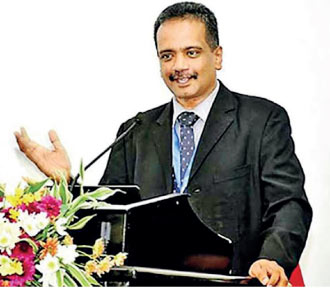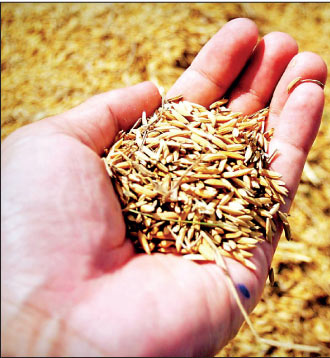Friday Feb 21, 2025
Friday Feb 21, 2025
Thursday, 20 February 2025 00:00 - - {{hitsCtrl.values.hits}}
|
Sri Lanka’s staple food, rice, is grappling with a myriad of challenges as farmers continue to demand higher purchase prices for the harvested paddy, production plummets due to poor productivity and floods, while a maximum retail price declared by the Government has triggered a shortage of rice countrywide. Compounding the crisis, experts now point out that the country will have to import a significant quantity of rice this year, which is a stark contrast to the ruling Government’s electoral promise to end rice imports and ensure better prices for farmers. As these issues present a formidable challenge for the Government, the Daily FT caught up with Senior Professor Buddhi Marambe of the Agriculture Faculty of the University of Peradeniya to seek his views and remedies on the current issues.
 Q: After a long delay the Government announced the prices for paddy. However it appears that the majority of farmers are not happy with the prices. What’s your opinion on this?
Q: After a long delay the Government announced the prices for paddy. However it appears that the majority of farmers are not happy with the prices. What’s your opinion on this?
It looked a non-starter, but finally the Government came up with a minimum purchase price for paddy by the Paddy Marketing Board (PMB) in the current Maha season, under three different categories, Nadu (Rs. 120/kg), Samba (Rs. 125/kg) and Keeri samba (Rs. 132/kg).
When the average paddy yields of the five past Maha seasons are considered, paddy yield in this Maha season would be lower by at least 350,000 Mt. It is obvious that lower yields would increase the cost of production per kg of paddy. Hence, practically, the estimated upper limit of the cost of cultivation to reach the minimum price for purchase of paddy by the Paddy Marketing Board (PMB) may not be realistic.
Farmer representatives appeared in press conferences making their intentions clear, and mostly demanding a price for Nadu-type between Rs. 130 and 140 per kg. Though the paddy purchase price proposed by the Government seems a good mid-point, it is far below these expectations and the displeasure is reflected by the reluctance to sell their product to the PMB, at least for now and sell it to the private sector. In fact just last Friday (14 Feb) the PMB Chief at a press conference declared that only 675 kg of paddy had been purchased by PMB.
 |
| Professor Buddhi Marambe |
 |
| Carefully assessed decisions should be taken if the cultivated extent in the next Yala season is to be increased to compensate for the loss of yield in this Maha season
|
Q: The Government has allocated Rs. 5,000 million for paddy purchases. Is this sum adequate?
The Government pledged that PMB and other Government-supported entities will purchase paddy to the tune of 300,000 Mt in this season, to ensure price stability in the market overcoming any manipulation of main millers. However, allocation of Rs. 5,000 million will only allow the PMB, purchasing 41,666 Mt of Nadu-type paddy at Rs. 120 per kg, assuming a one-time purchase using the full allocation (the quantity will be much lower for samba and keeri samba). Once converted to rice, this quantity will be adequate to feed the nation for only four days. Hence, the role play of the PMB to stabilise rice market prices is questionable at this stage. Further, if the PMB wants to have buffer stocks, it should consider the expected low yields in this Maha season, as storage of paddy even by PMB will deepen the rice crisis, unless the procured amount is quickly converted to rice and released to the market.
Q: And how does all this affect the retail price of rice in the market?
The impact of current paddy purchase price on MRP of rice will not be felt soon. It will take another 1-2 months for the rice markets to get affected. Currently, farmers also empty their limited storage to the markets to replace stocks they need to store for consumption and for sales at later stages to procure their daily needs. The wet-paddy is currently purchased at a lower price and thus will have some cushioning effect on the rice prices. However, it is well-known that the dried paddy will be stored for 2-3 months at least to ensure a better milling outturn, increasing the costs incurred due to storage. Hence, together with the other operational costs, the market price of rice would certainly go beyond the current MRP and the Government will need to re-visit the prices fixed at present. It is important that the general public is made aware of the realistic situation of rice price rather than making efforts to artificially keep it lower. All in all, we are in an open economy. Price control is not the way to manage markets.
Q: It appears that the large scale rice millers will benefit from the current situation and continue to dominate the rice market and call the shots?
This is what I see as well. On one hand, the large-scale millers send their vehicles to the door-step of the farmer to purchase paddy even at a higher moisture level. On the other hand, the farmer will have to take paddy to the door-step of the PMB stores for the same purpose, but after drying to 14% moisture or less. The natural tendency is that the large and medium-scale millers will dominate the situation. I see that some technocrats show satisfaction that farmers receive a high price by selling their produce to private millers. However, the resulting failure to procure expected levels of paddy by PMB would lead to irreversible reactions in efforts to stabilise price and failing to fulfil its promises given to the people.
Further, it is also important to assess the outcome of the Pledge Loan Scheme given to small and medium-scale millers to procure paddy and to those who store paddy. The general public should be educated about the pledge made with the banks to purchase price, more importantly the pledged price.
Q: Do you feel Sri Lanka will have to import rice in 2025?
This Maha season has shown signs to yield the lowest paddy production compared to all Maha seasons since 2018/2019, except 2021/2022 Maha season. The farmers and main millers are well aware of this low production, and have moved swiftly to ensure their purchase, to ensure continued milling of paddy for the next few months (after a few months of storage). It is important to note that the availability of rice will be further low as practically, the conversion from paddy to rice in commercial mills (big or small) is lower than the current estimated conversion rate of 68%. The Government should immediately re-visit this conversion factor which gives erroneous signals to make decisions. Estimation of purchase price of paddy and MRP for rice should thus be determined incorporating such changes every season in the future to reach a win-win situation for all stakeholders in the paddy-rice production system.
The missed production opportunity from the Maha season is difficult to be compensated for from the Yala season. Most reservoirs filled to their limits may provide a boost to paddy cultivation in the front-end of the next Yala season. However, carefully assessed decisions should be taken if the cultivated extent in the next Yala season is to be increased to compensate for the loss of yield in this Maha season, without missing opportunities for cultivating other cash crops where possible. Moreover, combined harvesters are heavily used today for harvesting paddy. However, there is no recommendation yet by the DOA or any competent authority to recommend working speed, the best maturity stage for using them, etc. Such research data are essentially needed to avoid losses that could incur in using machine harvesting and provide better signals to the private sector and the farmer to enhance productivity.
In my analysis, we will have to import rice to the tune of about 350,000 Mt of rice to meet the local demand. The quick calculation can be made early based on total paddy production in this Maha season, and the cultivation extent in the next Yala done mid-season (without waiting until the end of next Yala). Once decided, scattered import of rice is recommended in June-July, and November-December without creating an artificially large number of placement of orders within a short time period. This will reduce pressure at origins of export reducing chances of increasing rice export prices. Such scattered importation based on the needs, will not only help stabilise the market price of rice, but satisfy the needs of both the primary producer and the consumer.
Discover Kapruka, the leading online shopping platform in Sri Lanka, where you can conveniently send Gifts and Flowers to your loved ones for any event including Valentine ’s Day. Explore a wide range of popular Shopping Categories on Kapruka, including Toys, Groceries, Electronics, Birthday Cakes, Fruits, Chocolates, Flower Bouquets, Clothing, Watches, Lingerie, Gift Sets and Jewellery. Also if you’re interested in selling with Kapruka, Partner Central by Kapruka is the best solution to start with. Moreover, through Kapruka Global Shop, you can also enjoy the convenience of purchasing products from renowned platforms like Amazon and eBay and have them delivered to Sri Lanka.
Discover Kapruka, the leading online shopping platform in Sri Lanka, where you can conveniently send Gifts and Flowers to your loved ones for any event including Valentine ’s Day. Explore a wide range of popular Shopping Categories on Kapruka, including Toys, Groceries, Electronics, Birthday Cakes, Fruits, Chocolates, Flower Bouquets, Clothing, Watches, Lingerie, Gift Sets and Jewellery. Also if you’re interested in selling with Kapruka, Partner Central by Kapruka is the best solution to start with. Moreover, through Kapruka Global Shop, you can also enjoy the convenience of purchasing products from renowned platforms like Amazon and eBay and have them delivered to Sri Lanka.